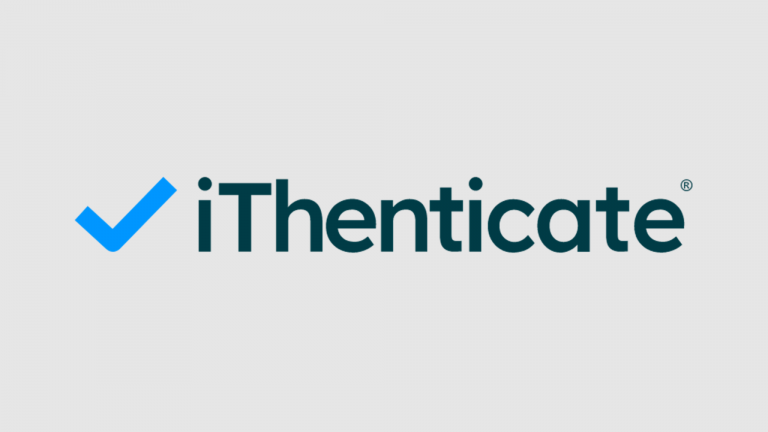■ Guides to bibliographic references writing
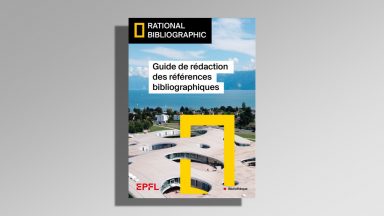
Rational Bibliographic
Freely available online, or on request in printed version at the Library desk.
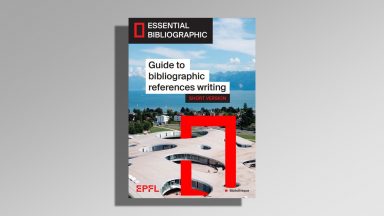
Essential Bibliographic
Short version, freely available online.
■ Basic rules
Copyright protects two types of rights: moral and economic rights. Only the economic rights can be transferred (e.g. publisher). The author is and always remains the author of his work (moral rights). Only the author (or the right holder) can authorize or not the use of his work.
The concept of moral rights does not always exist as such in the legislation of common law countries (United Kingdom, United States, Canada and Commonwealth countries in particular), at least moral rights in these countries are sometimes transferable.
In the directives, EPFL has gathered the rules regarding the use of sources and citations. These rules are universally valid in scientific and academic environments and are mandatory. One of the directives is destined specifically for students, while the other, included in the directive on scientific integrity, specifically concerns researchers.
- Directive concerning the citing and referencing of sources in written work submitted by students.
- Directive concerning research integrity and good scientific practice
- Federal Act on Copyright and related Rights (LDA)
- Terms of use for EPFL Library’s electronic resources
It is important to note that EPFL’s rules go beyond Swiss copyright law (LDA). In scientific and academic environments, both in Switzerland and abroad, the rules are stricter than in general society.
Citation allows readers to highlight the materials drawn from other publications and thus to distinguish these parts from the author’s personal and novel contributions.
“If the material originating from elsewhere is not clearly indicated in the work, the student allows the reader to think that it is their personal and original contribution. This amounts to cheating (plagiarism Art. 8). (Lex 3.3.3, section 2, art. 4).
Failure to respect the rules of citation is called plagiarism, which gives rise to the launching of an internal disciplinary procedure. Moreover, relying on duly documented and well-founded information gives credibility to the work. The originality of the work is then easier to highlight.
Finally, the references provided by the author, those which enabled the writing of the document, are useful for the readers who want greater insight into the subject. They are also essential for proofreaders to check the reliability of the sources used.
- Anything that is not a novel, personal contribution must be cited. This also includes content drawn from the author’s own published work (citing oneself), to avoid presenting previously published work as new. Failing to abide by this rule is a form of fraud referred to as self-plagiarism. Whenever possible, citations should refer to published documents that are accessible to the reader. It may however occur that the author’s work is based on documents (reports, internal documents, etc.) that have not been published in the past. Since these documents can not be referred to by the reader, their validity may be called into question. Citing unpublished documents should, therefore, be an exception. A citation can involve reproducing a passage literally from a source, or it can involve passages deriving from a source, but rewritten and structured by the author.
|
Hint: As mentioned above, realizations of ideas are protected by copyright. That means that graphs may be reproduced based on the data they represent (while it is prohibited to reproduce them in their original layout). |
A citation has to satisfy the following three points:
- The passage that is copied must be marked (unless the author choses to paraphrase)“A computer which can calculate the Question to the Ultimate Answer, a computer of such infinite and subtle complexity that organic life itself shall form part of its operational matrix.” (Adams, 2005, p.234)
- An in-text citation that refers to the bibliography must be inserted“A computer which can calculate the Question to the Ultimate Answer, a computer of such infinite and subtle complexity that organic life itself shall form part of its operational matrix.” (Adams, 2005, p.234)
- An accurate and complete reference must be included in the bibliography: ADAMS, Douglas, 2005. The Hitchhiker’s Guide to the Galaxy. London : Pan Books. ISBN 0-330-25864-8
- If the author reproduces content but reformulates the idea in his own words, only points 2 and 3 apply.
- Reference management programs, such as Zotero, automatically format references to match a specified format. These programs automatically generate the bibliography based on the works that are cited in a publication.
- By publishing images under a Creative Commons license, the copyright holder explicitly grants permission to use the images. In all other cases, the copyright holder can be acknowledged by writing: “Courtesy of …”.
- To cite source code, in whole or in part, the author should provide sufficient information for the reader to locate the copied or modified code. The author is also obliged to abide to the license under which the original source code was published.
Principle
It is forbidden to reproduce an entire work without the express consent of its rightful owners. This typically concerns figures, images, computer codes and entire articles.
Exception
A distinction must be made between reuse for:
- The publication of a work. In this context, the use of another’s work requires the approval of the rightful owner. If the work has several authors, the authorization of each of them is necessary (even if it is one of the authors who wishes to reproduce the work). The publisher’s authorization is also mandatory if the authors have transferred their rights at the time of the publication of an article, chapter, etc.
- A work for strictly personal use (not published) or for educational purposes. This is a right granted by copyright law to the teacher and his/her students to use and reproduce certain types of works without seeking permission from the copyright owner.
Check the Publishing Support Fast Guide #5 : Exception for education purpose for more information
|
Please note: this educational exception does not allow a student to duplicate an entire work and make it available to class members. |
By plagiarizing, a student exposes himself to penalties that can range from a zero grade for his paper to, in repeated cases, exclusion from the school. In the case of a PhD candidate, plagiarism is punished more severely than for a Bachelor’s or Master’s student and can lead to the expulsion from doctoral studies, even without precedent. Plagiarism detected at a later time can lead to the revocation of the doctoral degree. EPFL uses software to monitor work for plagiarized elements.
The consequences that plagiarism can have for a researcher are defined in an EPFL directive:
- Plagiarism or self-plagiarism, whether committed intentionally or by omission, constitutes misconduct, which gives rise to the launching of an internal disciplinary procedure.
Other consequences : plagiarism brings discredit to its author, which has repercussions on his research team, negates the value of the work carried out and brings disgrace on the institution involved. It may also give rise to external procedures.
(Directive concerning research integrity and good scientific practice at EPFL, art. 18, par. 3-4)
Victims of acts of plagiarism are advised to contact the offender or the institution the offender isaffiliated to, in order to call attention to the offense and to request rectification. If the offender does not abide, he or she can be prosecuted if the copyright holder presses charges (LDA, art. 67-73). The plagiarist can be fined, and if the author can provide evidence of financial losses incurred because of the event, the plagiarist can be required to compensate for these. If a member of the EPFL is involved, EPFL’s disciplinary law applies. In this case, [email protected]should be contacted.
■ Student works and copyright
This section specifically addresses students’ questions about work done as part of their studies. All basic rules are assumed to be known.
The student is the author and the copyright holder of his/her work (semester project, master project, etc.).
If a teacher wishes to reproduce an extract from a student’s work, he or she may do so by citing its source (even if the work has not been published). If (s)he wish to reproduce a large part or all of a student’s work, the student’s prior consent must be obtained . The student may then accept and become a co-author of the publication or refuse (e.g. the student plans to publish the work himself or herself or to use it in some other context).
In the context of a project carried out in a company, the student remains the author of the work but is not necessarily the rights holder. It depends on the contract signed with the company. If the contract does not stipulate anything about it and the work is remunerated, the company holds the economic rights. Otherwise (no remuneration and no verbal or written contract), the student is the rights holder and is free to transfer the work to the company.
Software created as part of a student’s work (semester project, bachelor’s or master’s work, internship) belongs to its author, unless the author has been remunerated for this work.
The confidentiality clause can also be part of the contract concluded with the company. If this clause extends to the work, the student is prohibited from disclosing the company’s data used for the work, outside the restricted circle of the responsible teacher and the expert.
A student is entitled to publish his or her work as long as (s)he has cited each of the sources used and has obtained permission from the rights holders to distribute the images. As author, (s)he is the only person who can decide whether (s)he wants to publish or reproduce the work. If there are several authors, the publication or reproduction of the work is subject to the agreement of each of them. For the deposit and the dissemination through the institutional archive Infoscience, it is necessary to check with the section for any special conditions.
The educational exception (Fastguide #5) defined in art. 19 par. 1b of the LDA does not apply to publication.
As the author of the work, the student is the only one who can decide whether or not to disclose it (both internet and intranet). Unlike a doctoral thesis that must be published, student projects may remain undisclosed.
The name of a professor is engaged when (s)he has reviewed the student’s work and judged it as at least sufficient. Otherwise, if the work has not been checked or has been deemed insufficient, the student must specify for publication that the work has not been checked, or must add the mention “Not approved by the EPFL”.
The partial reproduction of a work is authorized in all cases. However, the reproduction of a complete work is permitted only for strictly private use (LDA art. 19) and is not permitted for educational purposes.
An image is considered to be a complete work, while an extract from a video or soundtrack is not.
Making the reproduced work available outside the restricted circle of family and friends is forbidden. This includes the publication on the freely accessible web (website, blog, wiki, etc.). Making a work available on a restricted access space (intranet with authentication or Moodle), requires the consent of the copyright holder.
A person can only publish or make available on the web the works for which (s)he owns the rights. However, if (s)he wishes to publish the work of another author or made in collaboration with another person, the explicit permission of the right holder is required. Therefore, a student cannot put online / copy a teacher’s course materials (quizzes, series of exercises, exams, etc.).
On the EPFL campus or via VPN, EPFL students have access to electronic resources such as scientific journals. Students can use them professionally and privately in accordance with Fair Use and the licenses negotiated by the institution. For access to software, students must contact their faculty.
■ Research and copyright
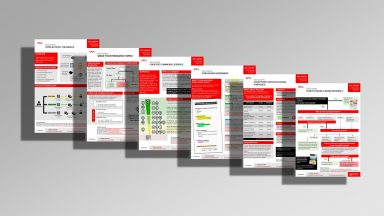
Publishing Support Fast Guides
Open Access: the basics | Make your research open | Creative Commons Licenses | Publishing agreement | Exception for educational purposes | How to reuse a work properly
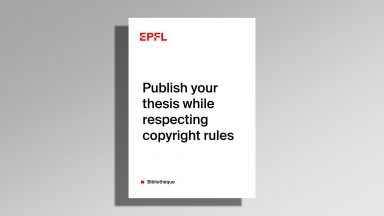
“Publish your thesis while respecting copyright” guide
This detailed guide provides information on how to reuse other content while respecting the rules of copyright.
This section specifically addresses researchers’ questions about work done as part of their research activities. All basic rules are assumed to be known.
A work produced in Switzerland is automatically protected by the Swiss Copyright Law, which exhaustively regulates the exceptions in favour of the users of the works, including the right of quotation, the right of private copying, the exception for teaching purposes as well as the duration of copyright.
These rules are universally valid in scientific and academic environments and are mandatory. EPFL Directive Lex 1.3.3 sets out the rules concerning the use of sources and citation. Detailed information regarding citation can be found here.
In the case of images or entire works (an entire article, for example), it is no longer a question of citation, but of reuse. This requires the permission of the author or the rightful owner (often the publisher) of the work. This is, for example, the case of the theses made of a compilation of published articles.
The European Union and some countries have integrated an exception in favour of the scientific practice of Text and Data Mining (TDM) into their copyright law . Switzerland recently introduced an exception into the legislation (art. 24d) on April 1st, 2020. However, this exception alone often does not allow TDM, as the licenses signed by the Library for access to electronic resources may prohibit it (see the terms of use for EPFL Library’s electronic resources). In this case, a new agreement may be necessary.
In the frame of traditional publications (subscription-based journals), the author signs a contract with the publisher. This contract may involve a total or partial transfer of copyright and may also be governed by a foreign law. The author is entitled to negotiate clauses in order to retain certain rights over his publication (especially the re-use rights).
In order to help authors in this negotiation, EPFL provides an amendment to the copyright agreement that can added to the publication copyright or to be submitted directly to the editor in charge of the publication. The instructions for use can be found here. There are two variants: the first requesting the permission to deposit the postprint version of the publication in Infoscience no later than 6 months after the date of publication; and the second that also adds the right to reuse the publication in an academic context. Other amendments exist, such as that of SPARC (Scholarly Publishing and Academic Resources Coalition) or that of the European Commission’s H2020 program.
Even if the publisher refuses to consider the amendment, it is still possible to negotiate other clauses in the contract (Fastguide #4).
In the context of Open Access publications or free distribution, the author retains his rights, but the question of which license to apply to the publication arises. Creative Commons licenses allow the author to decide what rights (s)he wants to grant users of the publication (Fastguide #3).
In the field of software, some of them are under free licenses allowing users to study and modify it. The Free Software Foundation offers a list of existing free licenses.
Do not hesitate to contact the Library for any help on these issues (reading contracts, requesting permission from publishers, choice of licenses, etc.).
Theses, inventions and software
At EPFL, a doctoral thesis belongs to its author, inventions and software made by PhD students or researchers belong to EPFL.
At EPFL, similarity check is available through iThenticate.
PhD theses accepted by a jury must be published in full (Ordonnance sur le doctorat délivré par l’EPFL, 2008, art. 19).
The Directive concerning doctoral studies at EPFL states that doctoral students hold the copyright on their work.
- Doctoral students are considered authors of their theses, as outlined in copyright law. According to par. 2, they hold all rights that follow from the copyright.
- EPFL has the non-exclusive right to use all or part of doctoral theses to increase the visibility of their contents if it supported the doctoral students by financing their work or by providing them with logistical support.
(translated from Ordonnance sur le doctorat à l’EPFL, 2008, art. 25)
It follows that the author may publish his thesis with an publisher. EPFL reserves the right to non-exclusively distribute the thesis in accordance with the conditions outlined on the webpage Theses.
The thesis is systematically made available:
- at the EPFL library (hard copy)
- on Infoscience (soft copy)
If results were obtained in the context of a project funded by a third party, the PhD student must consider any potential contractual clauses agreed apon with the third party before deciding to publish them.
Publish your thesis while respecting copyright rules
It is very common to reuse published (or unpublished) content in a thesis (e.g. in the case of the theses made of a compilation of published articles). It is therefore important to ensure that the use (or reuse) is possible and to ask for authorizations from the right owners when necessary. This guide provides information on how to reuse other content while respecting the rules of copyright.
References
Ordonnance sur le doctorat délivré par l’EPFL [online], 2008. 1 September 2008. RS 414.133.2. [Accessed on August 17, 2022¨]. Available at: http://www.admin.ch/opc/fr/classified-compilation/19994202/200809010000/414.133.2.pdf (in French)
Useful links
When EPFL researchers (or PhD candidates) make an invention in the course of their professional activity, the invention belongs to EPFL.
- With the exception of copyright, all other rights to intellectual property created during the official duties of persons in an employment relationship as defined in Article 17 [of the Federal Act on the Federal Institutes of Technology] shall belong to the FITs [Federal Institutes of Technology] and research institutes.
- The exclusive right to use computer programs created by persons in the course of their official duties in an employment relationship as defined in Article 17 shall rest solely with the FITs and the research institutes. The FITs and research institutes may enter into binding arrangements with the holders of other categories of copyright for the assignment of those rights.
- Persons who have created intellectual property as defined in Clauses 1 and 2 shall be entitled to an adequate share in profits generated by its exploitation.
(translated from Loi fédérale sur les écoles polytechniques fédérales, 2013, art. 36, par. 1-3)
Researchers are called to Notify the Technology Transfer Office (TTO) of any inventions they make to evaluate their patentability and commercial potential.
If an invention is the product of a collaboration with other institutions, the allocation of the rights is defined in a partnership agreement. The TTO is available to assist researchers in writing such agreements.
If a researcher (or PhD candidate) writes the entire source code for computer program in the course of his or her activity at EPFL, EPFL is the owner of the source code.(Federal law on the Federal Institutes of Technology, 2013, art. 36, par. 2)
If the work is based on code that is openly available, the license that applies to the original code is adopted.
The TTO is available for more information on this subject: [email protected].
References
Loi fédérale sur les écoles polytechniques fédérales [online], 2013. 15 February 2013. RS 414.110. [Accessed on August 17, 2022]. Available at: http://www.admin.ch/opc/fr/classified-compilation/19910256/201302150000/414.110.pdf (in French)
Useful links
■ Copyright and teaching activities
This page provides information to teachers on their course materials and the use of materials or works as part of their teaching activities. All the basic rules on citation are considered to be known.
The lecturer owns the rights on the course materials he/she has created.
The exception for teaching purposes (Fastguide #5) allows the teacher to use works or parts of works protected by copyright in the context of his/her courses, provided that the rights holders are properly credited.
Instructors retain the copyright on the course materials they created. As their employer, EPFL has the non-exclusive right to use these materials.
Course materials, collections of exercises, and exams are protected by copyright as long as they can be considered an intellectual creation with individual character as outlined in article 2 of the Loi fédérale sur le droit d’auteur et les droits voisins.
If students contributed to the preparation of lecture notes, the instructor has the right to freely use their contributions but is required to cite them or to specify them as co-authors.
Adding a © sign has no influence on the protection of a published work. It is, however, recommended to add a warning statement to lecture notes, such as:
“Any reproduction or distribution of this document, in whole or in part, is prohibited unless permission is granted by the author.”
The pedagogical exception (Fastguide #5) allows a teacher to use works or excerpts of works, however (s)he must imperatively:
- Clearly indicate his or her sources
- Respect the rules of citation
Depending on the type of work, rights may differ :
A teacher can distribute to the students excerpts of works, but cannot distribute a whole work. If students need to own a copy of a work (e.g. textbook, book, etc.), they have to borrow or buy it.
A teacher may, however, show audio or audiovisual documents in their entirety to the class.
In order to avoid any inappropriate use, it is recommended to add a mention “reproduction and distribution prohibited” on (excerpts of) works distributed in class.
The above rules do not exempt from the citation rules.
The deposit of a handout in Infoscience, even with restricted access to EPFL members, is not covered by the pedagogical exception (Fastguide # 5), which allows content protected by copyright to be shared within a class (including virtual as with Moodle). Therefore, it is essential to check the following points before any dissemination:
- Do several authors have contributed to the handout? If yes, it is necessary to request permission from all co-authors.
- Does the handout contain quotes and/or excerpts from other works of which the teacher is not the author (e.g. an exercise taken from a book)?
-
- Yes, but the extracts in question are short or of a small extent in scope compared to the original document. In this case, the sources must be cited according to the usual rules.
- Yes, large excerpts and/or entire chapters, pictures, or graphics are taken from other works. In this case, in order not to infringe copyright, it is necessary to request authorization from the rights holder (generally authors or publishers) and to cite the sources according to the usual rules.
- Yes, but the work from which the extract is taken is distributed in Open Access under a Creative Commons license (Fastguide # 3). In this case, the sources must be cited according to the usual rules.
- No: no specific recommendation
- Does the handout contain excerpts from articles or books of which the teacher is the author and which have been previously published?
-
- Yes, and there is only one author: for large extracts, entire chapters, pictures, or graphics, it is important to respect the copyright agreement with the publisher. In case of doubt, it is recommended to contact the publisher and ask for permission to reuse. Moreover, the citation rules in point 2 apply.
- Yes, and there are several authors: in addition to the previous recommendations (3a), permission from other authors is required.
- No: the teacher still owns his/her rights and can reuse the content at its convenience.
The teacher is responsible for the content in Infoscience. In case of doubt, please contact the Library’s copyright team at [email protected].
Provided that the consent of co-authors and the authorizations for third-party materials reuse have been obtained, an instructor may also share the courses materials under a Creative Commons license to authorize their reuse (Fastguide #3) and it’s recommended to add the following statement:
- Minimal statement:
This document is shared under Creative Commons Attribution (CC BY https://creativecommons.org/licenses/by/4.0)
- Additional optional statement (that explicit rights):
You may use, distribute, and reproduce the material by any means and in any format, provided that you give credit to the author of the work.
- Additional statement mandatory whether the document contains external contents that are not under a CC-BY license. The wording is free and can be adapted as required.
Contents from external sources are not under a CC BY license and their use requires the authorization of their authors.
Unlike Moodle, MOOC (Massive open online course) is not covered by the pedagogical exception as the definition of “class” does not correspond to the spirit of the law. In the case of the MOOC, the author is not the sole rightful owner. The MOOC is distributed by a hosting platform that holds the rights to the additions (encoding, adaptation, etc.) but not to the course content, which remains the property of the author.
If the MOOC reuses third party works, you must ensure that you have obtained permission from the copyright holders (Fastguide #6)
